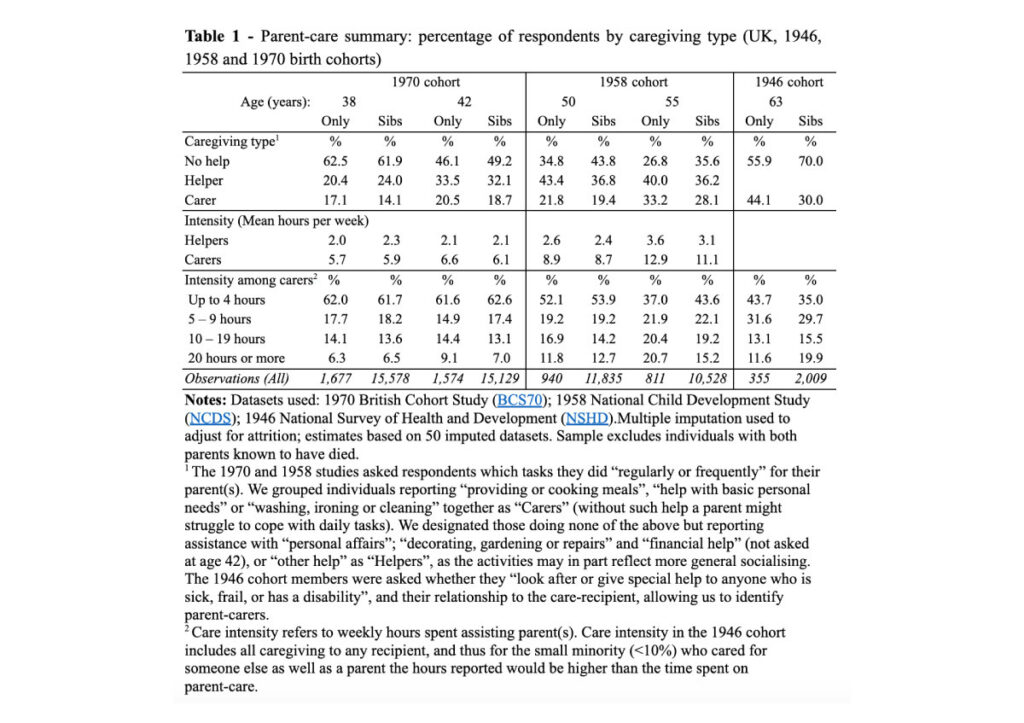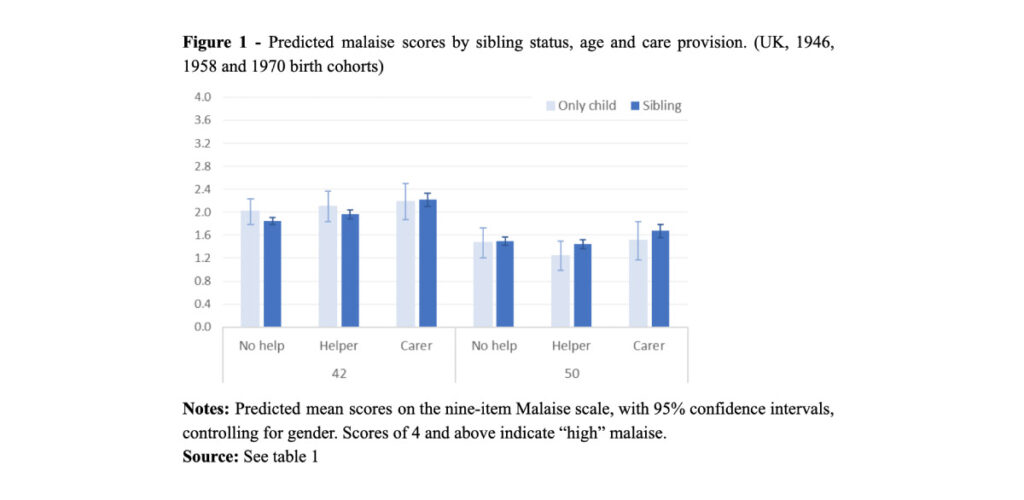Adult children with siblings can share caring for ageing parents but only children face this responsibility alone. Jenny Chanfreau and Alice Goisis find that adult only children are more likely than those with siblings to provide care. However, although caregiving is related to lower well-being, there is no evidence that only child parent-carers are more adversely affected.
Helping and caring for parents
The confluence of increasing longevity, declining family sizes and the projected informal care gap raises concerns about the future demand on a potentially shrinking pool of kin carers, yet little is known about the caregiving offered by adult only children. In a recently published article, we compare patterns of help and care given to ageing parents by only children and children with siblings at different ages in middle adulthood using data from three large-scale British birth cohorts, born in 1946, 1958 and 1970 (Chanfreau and Goisis 2022a). A key strength of these studies is that they have surveyed the same individuals from birth to middle age, so we were able to use information collected during childhood to identify those who did not grow up with siblings (Chanfreau and Goisis 2022b). As expected, among adults with at least one living parent, caregiving increases with age for everybody, in terms of both likelihood and intensity. Only children are, however, more likely to provide parent-care, especially at relatively older ages (e.g. 55 and 63 years). Thus, the pattern we find is consistent with an interpretation that differences by sibling status might increase with age. Nevertheless, when we focus on caregivers, the average weekly time only children spend providing assistance is similar to that of siblings who provide care.
Unfortunately, these studies do not collect information about, or directly from, other family members. This means we do not know about the parents’ other sources of care, including how much assistance is provided by other siblings. So, what can we infer from Table 1?

The differences by sibling status in rates of caregiving are compatible with some sibling groups adopting a “main carer” arrangement rather than sharing equitably, in that having a sibling reduces the chance of a given child providing care. If it was a common arrangement for siblings to share care concurrently, for example by alternating days of the week or dividing up tasks between them, we would expect lower intensity among those with siblings than among only children. However, among caregivers, we can test whether caregiving affects only children and those with siblings differently, for example by analysing caregivers’ well-being.
Carers’ mental health and well-being
Caregivers in larger care networks tend to report less stress; conversely, being a sole caregiver is linked to poorer mental health, but little is known about only children (Tolkacheva et al. 2011, Heger 2017). We may therefore hypothesise that assistance to ageing parents is more stressful or detrimental to caregiver well-being for those who are their parents’ only child, and thus the sole potential parent-carer. We find that both care status and intensity of assistance are associated with worse mental health and well-being but also that these differences are small (Figure 1). The predicted mean malaise scores range between 1.8 and 2.2 at age 42 and between 1.2 and 1.7 at age 50, on a 0–9 scale where scores of 4 and above indicate “high” malaise. We interpret the small magnitude of this finding as a reflection of the relatively low intensity of care provided by most filial caregivers. Further, as can be seen from the overlapping confidence intervals in Figure 1, we found no evidence that the association between caregiving and well-being differs by presence or absence of siblings.

We conclude that although as a group only children are more likely to provide parent-care and this is linked to lower well-being, we do not find patterns that would be consistent with their mental health being further affected by being an only child parent-carer.
This is a potentially reassuring finding. However, because the existing literature on only children has predominantly focused on outcomes in childhood and little is known about their adult lives, we emphasise that there is ample room for future research. Mental health is only one aspect of life potentially affected by parent-care; longitudinal evidence from England has suggested that informal caregiving in middle age can have negative consequences for employment even at fairly low intensities (King and Pickard 2013).
In institutional contexts that rely heavily on kin for eldercare, informal caregiving could thus represent a burden for only children that affects other aspects of life. Our analysis of patterns of caregiving across multiple ages shows that not only did higher rates of help and care among only children emerge at earlier ages but this was then maintained and increased at later ages. Siblings, conversely, can share care by alternating periods of main carer status, or share in the responsibility for ageing parents by emotionally supporting the main carer (Leinonen 2011).
References
Chanfreau, J. and A. Goisis (2022a). “Patterns of help and care by adult only children and children with siblings.” Ageing & Society.
Chanfreau, J. and A. Goisis (2022b). Research decisions regarding the concept and measurement with survey data. CLS working paper number 2022/3. https://cls.ucl.ac.uk/wp-content/uploads/2017/02/CLS-Working-Paper-2022-3-Defining-and-Identifying-Only-Children.pdf
Heger, D. (2017). The mental health of children providing care to their elderly parent. Health Economics 26(12): 1617-1629.
King, D. and L. Pickard (2013). When is a carer”s employment at risk? Longitudinal analysis of unpaid care and employment in midlife in England. Health Soc Care Comm 21(3): 303-314.
Leinonen, A. M. (2011). Adult children and parental care-giving: making sense of participation patterns among siblings. Ageing and Society 31(2): 308-327.Tolkacheva, N., M. B. Van Groenou, A. De Boer and T. Van Tilburg (2011). The impact of informal care-giving networks on adult children”s care-giver burden. Ageing and Society 31(1): 34-51.
Notes table 1
Notes: Datasets used: 1970 British Cohort Study (BCS70); 1958 National Child Development Study (NCDS); 1946 National Survey of Health and Development (NSHD).Multiple imputation used to adjust for attrition; estimates based on 50 imputed datasets. Sample excludes individuals with both parents known to have died.
1 The 1970 and 1958 studies asked respondents which tasks they did “regularly or frequently” for their parent(s). We grouped individuals reporting “providing or cooking meals”, “help with basic personal needs” or “washing, ironing or cleaning” together as “Carers” (without such help a parent might struggle to cope with daily tasks). We designated those doing none of the above but reporting assistance with “personal affairs”; “decorating, gardening or repairs” and “financial help” (not asked at age 42), or “other help” as “Helpers”, as the activities may in part reflect more general socialising. The 1946 cohort members were asked whether they “look after or give special help to anyone who is sick, frail, or has a disability”, and their relationship to the care-recipient, allowing us to identify parent-carers.
2 Care intensity refers to weekly hours spent assisting parent(s). Care intensity in the 1946 cohort includes all caregiving to any recipient, and thus for the small minority (<10%) who cared for someone else as well as a parent the hours reported would be higher than the time spent on parent-care.


